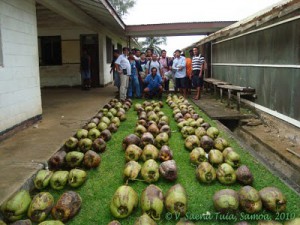You have been following the Adventures of Roland in Samoa, have you not?

Agricultural Biodiversity Weblog
Agrobiodiversity is crops, livestock, foodways, microbes, pollinators, wild relatives …
You have been following the Adventures of Roland in Samoa, have you not?

![]() It must have sounded like a great idea at the time. Uganda’s Kibale National Park (KNP) is scenic, diverse, important for the largest bit of mid-elevation tropical rainforest remaining in East Africa it contains, with its primates — and short of cash. But it also has wild robusta coffee (Coffea canephora) in its forest, and people in the surrounding areas still harvested it — illegally — for various ceremonies and other traditional uses. Why not legalize and control the harvest, and use the proceeds not only to improve livelihoods but also to keep the park running?
It must have sounded like a great idea at the time. Uganda’s Kibale National Park (KNP) is scenic, diverse, important for the largest bit of mid-elevation tropical rainforest remaining in East Africa it contains, with its primates — and short of cash. But it also has wild robusta coffee (Coffea canephora) in its forest, and people in the surrounding areas still harvested it — illegally — for various ceremonies and other traditional uses. Why not legalize and control the harvest, and use the proceeds not only to improve livelihoods but also to keep the park running?
It was such a good idea that USAID put up the money for project development, and the World Bank’s Global Environment Facility and the Ford Foundation paid for the project itself, starting in 2000. Some enabling policies were already in place. Since 1995, the national park legislation had allowed “revenue sharing and collaborative management with local communities, with provision for the creation of multiple-use zones within parks for sustainable resource use.” It was all very promising.
And yet by 2005 the project had collapsed. Why it did is explained in an instructive paper in Conservation Biology by some of the people involved. 1
The Kibale Forest Wild Coffee Project got off to a pretty good start. A non-profit foundation was established to “oversee harvests, pay harvesters, and return profits from the sale of wild coffee to harvesters, KNP, and local communities through the funding of jointly agreed upon projects.” A sustainable harvest system was devised. Wild coffee distribution was carefully mapped. An internal control system was put in place to set and monitor sustainable levels of coffee harvest. Organic certification was achieved.
But then things started to go wrong. Blending of the wild coffee with the local arabica didn’t work so well. Initial harvests were low, and world prices fell. Increasing insecurity didn’t help. Alternative markets for extracts (inspired by “Ben and Jerry’s Rainforest Crunch ice cream, and The Body Shop’s Brazil nut oil hair conditioner”) failed to materialize. Alas, “[b]y 2005, …funds for efforts to market Kibale’s wild coffee were exhausted and project funding, originally envisioned to be replaced gradually by sales revenues, fell to levels insufficient to maintain staff.”
Bummer. But can we salvage something from the debacle? The authors think so.
Despite these setbacks the search for self-sustaining and market-based conservation models is likely to continue in Kibale and elsewhere. Given the project’s innovative approach and significant level of effort and support, a review of its successes and failures provides useful lessons for other attempts to sustainably market wild-grown products to serve both conservation and development goals. The lessons include (1) fostering the creation of collaborative partnerships, (2) controlling the high costs of monitoring and certification, (3) carefully planning for the periodicity of wild harvests, (4) avoiding commodity pricing through the creation of new products and markets, and (5) maximizing the value of indigenous knowledge.
The most difficult thing, according to the authors, was “gaining a foothold in the international coffee market.” Which might perhaps have been predicted. It was certainly a bit of a surprise to me that the local market was not more thoroughly explored. Surely there are plenty of tourists in Kampala (and perhaps even Nairobi) who might be tempted by local wild coffee drinks and the like? Why not start with them before venturing into the shark-infested waters of the international markets? Anyway, the failure to crack these markets led to perhaps the key insight, which is that
…”the story” of Kibale coffee was potentially of far greater value to consumers than the actual product itself. This recognition, likely to hold true for other ecoproducts, may better place the product within more-specialized and less-competitive markets. Moreover, maximizing the value of the story, instead of the quantity of the harvest, decouples market-driven pressures to increase revenues through unsustainable harvesting.
And the story includes the rich knowledge that local people have about the wild coffee and its habitat, and the role they have played in managing that and other resources within the park, and outside it. It seems that for Kibale’s wild coffee, and perhaps other wild-harvested commodities, it is the message that is the product.